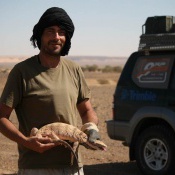DESERTFLOW – Assessing gene flow and contact zone dynamics in desert lizards under climate change scenarios
Rapid anthropogenic climate change is eroding global biodiversity and predicting species responses to climate oscillations is crucial to forecast consequences of global warming. Environmental change-induced hybridization may be common phenomena in contact zones between genetically differentiated populations or evolutionarily significant units (ESUs), and although it may cause diversity lose by genome replacement and consequently fitness declines, hybridization may also increase the evolutionary potential of populations and facilitate adaptation to climate change. Gene flow and reproductive isolation among populations can be affected by climate change, especially when population connectivity is tied to climatic gradients. Challenges are to identify the role of climate and landscape features in modulating gene flow and driving contact zone dynamics to assess future ESU vulnerability to climate change. Warm deserts are excellent areas to study contact zone dynamics under climate change. They offer patchy distributed species and highly diverse taxa, climatic extremes that promote ecological gradients, and are sensitive to high velocities of climate change.
This study addresses the role of environmental factors in the dynamics of contact zones in desert landscapes under climate change scenarios, using lizard populations of Acanthodactylus scutellatus species group and Agama boulengeri as models. We want to verify the common but rarely evaluated assumption that climate and landscape features are the most important features defining the extent of ranges, connectivity and gene flow between populations/ESUs. If this is indeed the case, as we anticipate, forecasted climate changes will affect range and configuration of contact zones and dispersal corridors, which may result in genome vulnerability due to dilution by introgressive hybridization.
We will combine cutting-edge molecular and spatial analyses to derive integrative landscape models of contact zone dynamics according to climate change predictions. Phylogenetic and Population analyses are expected to answer the questions: i) how is genetic diversity spatially structured; ii) can we identify distinct ESUs within wide ranging species; iii) is there gene flow between ESUs or even between species? Landscape analyses are expected to answer the questions: i) are locations of contact zones and of suitable areas of occurrence driven by spatial patterns of variation in climatic or landscape features; ii) are gene flow levels related to landscape resistance? Projection analyses are expected to answer the questions: i) where are consensus predictions of future ESUs ranges and contacts located, ii) where will future corridors for gene flow be located; iii) are ESUs endangered by shifting hybridisation patterns and genome dilution?
The study is organised in four complementary tasks that rely on the interactive collaboration of team members:
Phylogenetic and Population: identify main ESUs and their ranges within study species, and population structure and gene flow levels between ESUs in contact zones, considering historical and recent divergence. It will be sequenced mitochondrial and nuclear gene fragments and fast-evolving markers (microsatellites) from georeferenced tissue samples previously collected. Model-based clustering methods will be used to infer population structure and coalescence-based approaches will estimate gene flow levels;
Landscape: inference of spatial patterns in genetic diversity, barriers in the landscape to gene flow, delimitation of hybrid zones, and estimation of corridor-specific gene flow rates at fine scales. Clines and areas of high genetical variability will be identified using GIS. Ecological models will be used to quantify relationships between ESUs presence and environmental variability, and predict distribution of ESUs and contact zones among them. Landscape modelling will be used to identify potential landscape and climate features acting as barriers to gene flow, and to estimate dispersal corridors between ESUs;
Projection: inference of future ESUs range and dispersal corridors in contact zones to estimate spatial/temporal contact zone and gene flow dynamics under climate change scenarios. Models of current ESUs occurrence will be projected into forecasted climate change scenarios to predict future suitable areas for ESUs and contact zones among them. Landscape modelling will be used to estimate future dispersal corridors between ESUs according to climate change scenarios, and infer potential ESU range shifts and gene flow patterns.
Project results will provide insights about contact zone and gene flow dynamics in desert environments, and will contribute to strengthen the present knowledge on evolutionary and adaptation mechanisms to extreme arid conditions. Results will allow deriving conservation strategies and priority areas in face of climate change.


